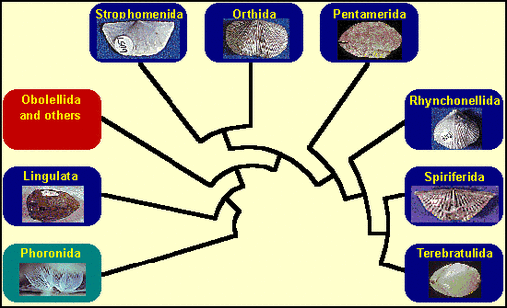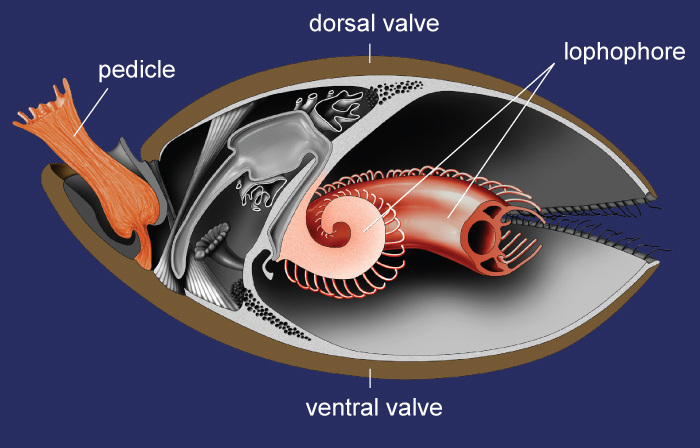 Brachiopoda (4)
Brachiopoda (4)
Description:
- Lophotrochozoan (1)
- Linguilformean brachiopod (1)
- Deuterostome (1)
- Marine animals that have hard "valves" (shells) on the upper and lower surfaces (5)
- Lack any form of shell articulation and rely on a complex internal musculature to keep the valves in place and to move them (1)
- Shells of lingulids are composed of calcium phosphate (7)
- The long pedicle facilitates burrowing; extant Lingula is typically found burrowed in soft muddy sediments with only the valve edges protruding (7)
Habitat(1):
- Lives in vertical burrows in soft substrates, generally close to the shore
- The animal itself also lives in a vertical position with the anterior edge of the shell at the sediment-water interface
- Cilia at the edge of the valves are formed into three distinct regions in order to create separate inhalant and exhalant psuedosiphons to aid the movement of water through the shell cavity to maximize feeding efficiency
- Restricted to littoral and sub-littoral environments
- Habitat varies from estuarine mudflats to fine sands to environments rich in coral reef debris
- Australasia, Indian ocean rim, North-west Africa, Japan, China
Nutrition(1):
- Is a suspension feeder; uses a soft, ciliated, fleshy ribbon-like structure to filter food particles from the water column. This structure (called a lophophore) is coiled within the two valves (shells) of the animal.
Reproduction(8):
- Sexually reproduces by dispersal spawning
- Gametes are released into the water column by the different sexes
- It is thought that it might be tidally or seasonally regulated
- The larvae have a long pelagic (neither close to bottom or near shoreline) phase; up to and over 6 weeks
- Settlement and pseudometamorphosis takes place and the larvae matures into the full adult form
Conservation Status (1):
- Because of their burrowing nature, predation is significantly reduced
- The most notable predator of modern lingulids is man In the Far East they are dug up during low tides and the pedicle is eaten under the name of ‘sea bamboo shoots’
Interesting Facts(1):
- In the Far East they are dug up during low tides and the pedicle is eaten under the name of ‘sea bamboo shoots’
- Often referred to as a living fossil

